组织行为学:OB模型
组织行为学:OB模型
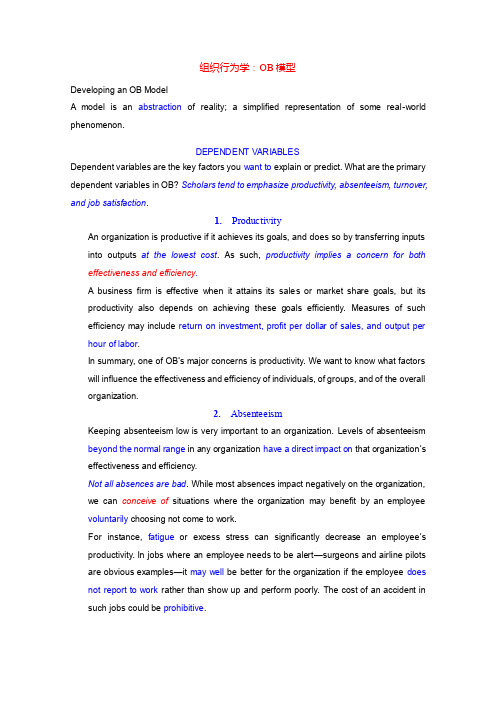
组织行为学:OB模型Developing an OB ModelA model is an abstraction of reality; a simplified representation of some real-world phenomenon.DEPENDENT VARIABLESDependent variables are the key factors you want to explain or predict. What are the primary dependent variables in OB? Scholars tend to emphasize productivity, absenteeism, turnover, and job satisfaction.1.ProductivityAn organization is productive if it achieves its goals, and does so by transferring inputs into outputs at the lowest cost. As such, productivity implies a concern for both effectiveness and efficiency.A business firm is effective when it attains its sales or market share goals, but itsproductivity also depends on achieving these goals efficiently. Measures of such efficiency may include return on investment, profit per dollar of sales, and output per hour of labor.In summary, one of OB's major concerns is productivity. We want to know what factors will influence the effectiveness and efficiency of individuals, of groups, and of the overall organization.2.AbsenteeismKeeping absenteeism low is very important to an organization. Levels of absenteeism beyond the normal range in any organization have a direct impact on that organization’s effectiveness and efficiency.Not all absences are bad. While most absences impact negatively on the organization, we can conceive of situations where the organization may benefit by an employee voluntarily choosing not come to work.For instance, fatigue or excess stress can significantly decrease an employee’s productivity. In jobs where an employee needs to be alert—surgeons and airline pilots are obvious examples—it may well be better for the organization if the employee does not report to work rather than show up and perform poorly. The cost of an accident in such jobs could be prohibitive.3.TurnoverVoluntary and involuntary permanent withdrawal from the organizationA high rate of turnover in an organization means increased recruiting, selection, andtraining costs. It can also mean a disruption in the efficient running of an organization when knowledgeable and experienced personnel leave and replacements must be found and prepared to assume positions of responsibility.Turnover often means the loss of people the organization does not want to lose. When turnover is excessive, or when it involves valuable performers, it can be disruptive factor, hindering the organization’s effectiveness.4.Job satisfactionJob satisfaction refers to a general attitude toward one’s job. The difference between the amount of rewards workers receive and the amount they believe they should receive.Job satisfaction represents an attitude rather than a behavior. The belief that satisfied employees are more productive than employees dissatisfied has been a basic tenet among managers for years.INDEPENDENT VARIABLESWhat are the major determinants of productivity, absenteeism, turnover, and job satisfaction? Our answer to that question brings us to the independent variables. Consistent with our belief that organizational behavior can best be understood when viewed essentially as a set of increasingly complex building blocks, the base or first level of our model lies in understanding individual behavior.1.Individual-level variablesPersonal or biographical characteristics such as age, gender, and marital status;personality characteristics; value and attitudes; basic ability level; Perception, individual decision making, learning, motivationThese characteristics are essentially intact when an individual enters the work force, and, for the most part, management can do little to alter them.2.Group-level variablesThe behavior of people in groups is more than the sum total of each individuals acting in their own way.The complexity of our model is increased when we acknowledge that people’s behavior when they are in groups is different from their behavior when they are alone. Therefore, the next step in the development of an understanding of OB is the study of group behavior.anizational system-level variablesJust as groups are more than the sum of their individual members, so are organizations more than the sum of their member groups.The design of the formal organization, technology and work processes, and jobs; the organization’s human resource policies and practices (that is, selection processes, training programs, and performance appraisal methods), the internal culture, and levels of work stress all have an impact on the dependent variables.。
组织行为学—OB组织文化

组织文化指在组织长期生存发展过程中培育形成的,由全体员工共同遵守的最高目标(宗旨)、(价值)标准、基本信念、(行为)规范、风俗习惯等的总和及其在组织活动中的反映,其核心是组织的(核心价值观)。
2.组织文化的特点
客观性
独特性(个性)
间接无形性:信念力量、道德力量、心理力量
软约束性
相对稳定性和连续性
3.组织文化的结构
精神层(观念层)
制度行为层
物质层(器物层)
组织文化的结构:
精神层
精神层是指组织的领导和职工共同信守的基本信念、核心(价值)观、经营哲学、组织宗旨、组织目标和职业道德等,它是组织文化的核心和灵魂,是形成制度层和物质层的(基础)和原因。
组织标志、标准字、标准色
产品的特色、品质、外观和包装等
技术工艺设备特性
组织的文化传播网络:例如报纸、刊物、画册等
4.组织文化的作用
导向作用
规范作用
凝聚作用
激励作用
整合作用
辐射作用
5.织文化的影响因素
民族文化
制度文化(政治、经济等制度)
外来文化
组织传统
个人文化因素(领导者、模范人物)
6.组织文化建设的内容
培育具有优良取向的价值观念,塑造杰
出的组织精神
坚持以人为中心,全面提高员工素质
提倡先进的管理制度和行为规范
加强礼仪建设,促进组织文化的习俗化
改善物化环境,塑造良好的组织形象
7.组织文化建设的心理机制
运用心理定势
重视心理强化 利用从众Fra bibliotek理 培养认同心理
激发模仿心理
组织行为学—OB沟通

.采取行政手段
–转移目标
–改变组织结构
–设置综合领导
–妥协
–教育
–压制、拖延或和平共处
冲突的处理—引起冲突的策略
为提高组织效率,应保持最适宜的冲突水
平。罗宾斯认为,如果发现人员流动率低,缺乏
新思想、缺乏竞争意识、对改革进行阻挠等
情况时,管理人员就需要挑起冲突。可采取
道解决问题更可靠。
.小道传播了正式沟通渠道不愿意传播的信
息。
.小道的传播速度非常快,这使管理者很难对
付不应有的谣言。
.小道消息越过公司的等级而自由的流动。
.小道消息很有影响力。
弱化小道消息不良影响的建议
公布进行重大决策的时间安排
.公开解释某些让大家觉得隐秘的决策
.对于当前的决策和未来的计划,在强调其
的策略有:
–委任态度开明的管理者
–鼓励竞争
–重新编组
沟通的概念
指个人、群体、组织之间传递
信息或思想,并达到共同理解
的过程。
–理解<> 同意
–人际沟通
人际沟通特点
主要通过语言进行
.信息+思想、观点、态度、情感……
.心理因素起重要作用
.会出现人特有的心理障碍
沟通对个体的重要作用
冲突的概念
.冲突是指两个或两个以上的社会
单元在目标上互不相容或互相排
斥,从而产生心理上或行为上的
矛盾。
冲突的来源
沟通因素
–信息来源表达偏差传递渠道不同
–双方态度、知觉等差异
.组织结构因素
–规模角色冲突权责分布
OB(2012秋导论)

前言
12/29/201 3
组织行为学 ORGANIZATION BEHAVIOR
□第6页□
6、对于一个美国商人来说,用手接触来自哪个国家的商人是不被接受的? a.日本; b.意大利; c.斯洛文尼亚;d.委内瑞拉, e.法国. 7、下面哪项是最合适的礼物? a.在中国送钟;b.在埃及送一瓶甜酒;c.在阿根廷送一套组合刀; d.在中国设宴请客; e.上述答案都不对。 8、下列哪—个国家有着最严格的社会等级? a.英国; b.美国; c.日本; d.印度; c.德国。 9、传统的西方银行业在下列哪一个国家中运行困难,因为这个国家的法律严禁给付利息? a.巴西;b. 沙特阿拉伯; c.蒙古; d.印度;e.希腊. 10、加拿大的首都是: a.多伦多;b. 渥太华 ; c.温哥华; d.安大略;e.蒙特利尔。
▲有效管理
弗雷德〃路桑斯(Fred Luthans)和他的同事们研究了450多名管理人员发现,这些管 理者都卷入了4类管理活动: 1、传统的管理: 决策、计划和控制; 2、沟通活动: 交换日常信息并处理书面资料; 3、HRM: 激励、训练、管理冲突、安臵、培训; 4、网络活动: 社交、政治活动、与外部交往。
第一章 组织行为学的研究对象
12/29/201 3
组织行为学 ORGANIZATION BEHAVIOR
□第11页□
二、管理者的角色——做什么事情?
60年代后期,麻省理工学院亨利〃明茨伯格 (Henry Mintzberg) 对5位高层经理研究得出结论: 管理者扮演着三大类(人际、信息和决策的角色)10种不同而又互相关联的角色。
4
领导领导能力/ຫໍສະໝຸດ 导风格/领导类型/领导理论等;前言
12/29/201 3
组织行为学—OB群体行为

称为人际关系。
.本质上是一种社会关系,不仅影响人们
的心理状态,且对社会群体的社会实践
发生重大作用。正确处理人际关系,对
缓解紧张情绪,提高群体士气和工作效
率,具有重要意义。
–人际关系对人们身心健康的影响
–人际关系对群体的影响
–人际关系对工作效率的影响
在群体目标和组织目标相(一
致)的基础上,增强凝聚力才
有利于提高群体生产率。
群体凝聚力与生产效率
群体目标与组织目标(一致)
性指标比凝聚力指标对于群体
生产率的影响更为重要,只有
在群体目标和组织目标相(一
致)的基础上,增强凝聚力才
有利于提高群体生产率。
群体决策
.群体决策是由多人组成的群体进行
会因团队规模过大而大打折扣。
建立优秀团队————团队成员
.团队的存在需要以下三类不可或缺的成员
.决策者:决策者把握总体方向,决定解决
问题的方案。
.技术专家:技术专家拥有(技术)专长,
确保产品和服务能够达到一定的标准。
.协调员:协调员帮助团队建立聆听反馈的
良好氛围,是解决(冲突)、协调成员间
霍煜梅
bupthuoyumei@
团队的类型
按照团队在组织中发挥的功能
(1)生产/服务团队
(2)行动/磋商团队
(3)计划/发展团队
(4)建议/参与团队
团队角色
贝尔宾的八种团队角色:
.主席
.造型师
.开拓者
.监控-评价者
.企业工作者
.团队支持者
组织行为学

OB重点集合第一章导论1.组织行为学定义和对其有贡献的学科定义:组织行为学是一个研究领域,它探讨个体、群体以及结构对组织内部行为的影响,目的是利用这些知识改善组织绩效。
有贡献的学科:心理学、社会学、社会心理学、人类学。
2.OB模型自变量:(1)个体水平的变量(个人的或传记的特征、人格特征、内在情绪框架、价值观与态度和基本的能力水平)(2)群体水平的变量(3)组织系统水平的变量因变量:(1)生产率(2)缺勤率(3)流动率(4)工作场所种的越轨行为(5)组织公民行为(6)工作满意度第二章能力与学习1.能力定义及内容定义:能力指的是个体能够成功完成工作中各项任务的可能性。
内容:(1)心理能力:即从事那些如思考、推理和解决问题等心理活动所需要的能力。
(2)体质能力:记那些从事技能要求较少而规范性要求较高的工作所需要的能力。
2.情商的五个方面自我意识:了解自己的感觉自我管理:监控自己的情绪自我激励:不断进取的动力感同身受:识别别人的情绪社交技能:与他人的交往3.能力-工作的匹配:高工作绩效取决于该工作本身对具体的心理能力和体质能力的要求,当能力与工作相匹配时,员工的工作绩效便会提高。
4.学习--在经验的作用下发生的相对持久的行为改变。
5.学习理论的内容:(1)经典条件反射(2)操作性条件反射(3)社会学习理论6.行为塑造的方法以及结论方法:积极强化:行为之后,给予积极刺激—行为变的更加可能发生消级强化:行为之后,取消消极刺激—行为变的更加可能发生惩罚:行为之后,给予消极刺激—行为变的更不可能发生忽视:取消所有强化物—行为变的不可能发生结论:(1)积极强化和消极强化都导致了学习,他们强化了反应,增加了其重复的可能性。
(2)惩罚和忽视消弱了行为,并减少了以后类似行为发生的频率。
7.强化程序和结论:程序:(1)连续强化:每一次理想行为出现时,都给予强化(2)间断强化:只对部分理想行为给予强化。
a固定时距:每隔一段固定的时间给与强化。
组织行为学个体模块的知识体系
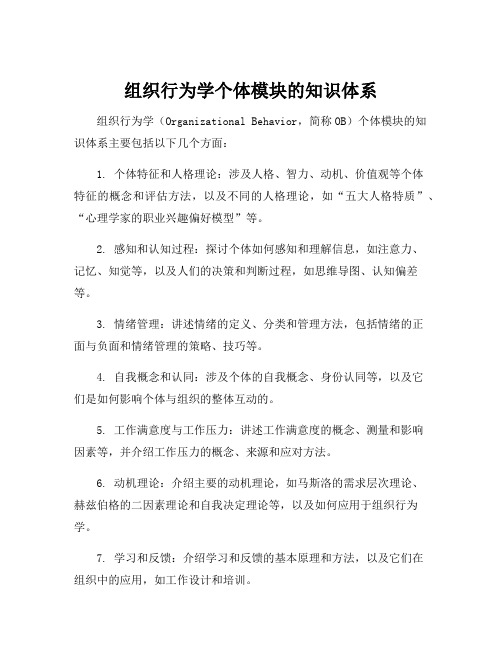
组织行为学个体模块的知识体系组织行为学(Organizational Behavior,简称OB)个体模块的知识体系主要包括以下几个方面:
1. 个体特征和人格理论:涉及人格、智力、动机、价值观等个体
特征的概念和评估方法,以及不同的人格理论,如“五大人格特质”、“心理学家的职业兴趣偏好模型”等。
2. 感知和认知过程:探讨个体如何感知和理解信息,如注意力、
记忆、知觉等,以及人们的决策和判断过程,如思维导图、认知偏差等。
3. 情绪管理:讲述情绪的定义、分类和管理方法,包括情绪的正
面与负面和情绪管理的策略、技巧等。
4. 自我概念和认同:涉及个体的自我概念、身份认同等,以及它
们是如何影响个体与组织的整体互动的。
5. 工作满意度与工作压力:讲述工作满意度的概念、测量和影响
因素等,并介绍工作压力的概念、来源和应对方法。
6. 动机理论:介绍主要的动机理论,如马斯洛的需求层次理论、
赫兹伯格的二因素理论和自我决定理论等,以及如何应用于组织行为学。
7. 学习和反馈:介绍学习和反馈的基本原理和方法,以及它们在
组织中的应用,如工作设计和培训。
8. 工作行为:讲述工作行为的概念和分类,如集体行为、组织公民行为、逆反行为等。
总之,组织行为学个体模块的知识体系围绕着个体的内在特征和行为方式展开,旨在帮助个人更好地理解和管理自己,从而更好地融入和贡献于组织。
人员管理 模型

人员管理模型
人员管理模型是用于描述和分析组织中人员管理过程和行为的模型。
它可以帮助组织理解员工的行为、态度、动机和绩效,以及如何通过有效的管理策略来提高员工的绩效和组织效率。
常见的人员管理模型包括:
1. 人力资源管理(HRM)模型:该模型将人员管理视为一个系统,包括招聘、选拔、培训、薪酬、绩效评估等环节,通过这些环节来吸引、保留、激励和开发人才。
2. 组织行为学(OB)模型:该模型关注员工在组织中的行为、态度和互动,包括沟通、冲突、压力等,通过研究这些因素来优化组织结构和员工关系。
3. 人力资源管理与组织行为学整合模型:该模型将HRM和OB 结合起来,强调综合运用HRM策略和组织行为学理论来提高员工绩效和组织效率。
4. 领导力模型:该模型关注领导者如何激发、指导和影响员工的行为,以提高组织的整体表现。
领导力模型通常包括领导风格、技能和价值观等方面。
5. 人员管理过程模型:该模型关注人员管理的各个阶段,包括招聘、选拔、培训、绩效评估、反馈和激励等,通过分析这些阶段来
优化人员管理的流程和效果。
这些模型的应用可以帮助组织更好地理解员工需求,提高员工满意度和绩效,同时也可以帮助组织制定更加科学和有效的管理策略。
组织行为学ob

目标设置+自我效能感
OP=IP
OP——自己对 所获报酬的感觉 OP——自己对 所获报酬的感觉
分配公平理论
公平理论
简 皮尔逊 Jane Pearson
OP/IP=OC/IC
OP——自己对所获 报酬的感觉
OC——自己对他人 所获报酬的感觉
OP——自己对所获 报酬的感觉
OP/IP<OC/IC
自我效能感理论
艾伯特 班杜拉 Bandura
案例 3
吴美美女是2009届我校初三毕业班学生;父母离异;在外婆家吃 饭;回妈妈家睡觉 到初三时因与妈妈不和;养成晚归的不良习惯;甚 至有一次整夜未归 妈妈如何劝说都没什么作用;我作为她的班主 任就晚上不回家这样事跟她长谈;谈到亲情;谈到理想;谈到自爱 之 后一个月内都有按时回家;也没有再发生不回家过夜的事 但在谈 话中劝说她要努力学习;争取考一个好的学校这个方面;虽然一开始 有些效果;但坚持两三天;便又见她放弃 而每次班主任的劝说都只 能让她努力一小段时间 因此在中考时;虽然成绩比平时稍有进步; 却不能让她考入理想学校
案例 2
坦丁姆计算机是詹姆士·特雷比格于1970年创建的 目前;它每年 的销售额达到3亿美元;计划10年以后的销售量达到10亿美元 詹姆士在斯坦福大学获得工程硕士学位后曾在得克萨斯仪器工作 过几年;随后便在硅谷区创建了坦丁姆计算机 该一开始就以生产 其第二计算机继续工作系统而著称 第二计算机继续工作系统就是 在一个系统中同时使用两台计算机 在正常的情况下;两台计算机 都工作;如果其中一台出了故障的话;而另一台就会自动地承担全部 的工作;使工作不间断地继续下去 同时;对系统中的计算机数据和 程序还有各式各样的保护措施 有了这种第二计算机继续工作系统; 工作就可以畅通无阻;避免不必要的损失 坦丁姆地处加州硅谷地 区;受到各方面的强有力竞争 由于剧烈的竞争环境;也由于詹姆士 本人的管理天才;他创造了一套有效而独特的管理方法 他为职工 创造了极为良好的工作环境 在总部设有专门的橄榄球场地 游泳 池;还有供职工休息的花园和宁静的散步小道等 他规定每周五下 午免费给职工提供啤酒;还经常定期举办各种酒会 宴会;同时还举 办由女职工担任裁判的男职工健美比赛等活动 除此之外;他还允 许职工有自由选择灵活机动的工作时间的自由 当然;詹姆士深深 地知道;要长期维持住这样一批倾心工作的职工确实不是一件容易 的事 随着的不断扩大;它的生产增长速度自然会放慢;也会出现一 个更为正式而庞大的管理机构 在这种情况下;应如何更有效地激 励职工呢 这自然是人们所关心的问题 詹姆士还可以采用哪些更 有效的激励方法呢
组织行为学模型

组织行为学模型
组织行为学(organizationbehavior,OB)是一个研究领域,他研究组织行为中德三个因素:个体、群体和架构。
组织行为学关注人们在组织中做什么以及这种行为如何影响组织的绩效。
目前虽然人们对于各项内容的权重依然有争论,但是组织行为学中的核心课题大家基本已达成共识,这些课题包括动机、领导行为和权利、人际沟通、群体结构与过程、学习、态度形成和知觉、变革过程、冲突、工作设计及工作压力。
在开始需要界定两个概念:管理者和组织。
管理者是通过别人来完成工作,管理者在组织中完成他们的工作,组织是一个人们有目的的组合起来的社会单元,由于是接着前面五篇管理学那些事已经详细阐述了管理者的各个方便,这里就不赘述。
— 1 —。
第一讲OB总论

• 领导
指导和激励所有参与者,并解决冲突
• 控制
监控活动进程,确保按计划完成
管理的职能
计划 •设定目标 •决定如何达到目标
控制 •监控业绩 •采取行动以保证达到 预定目的
管理的四个职能
组织 •将工作分成不同部分 •分配工作 •分配资源 •协调结果
领导 •产生愿景 •激发员工的投入 •指导员工朝某个方向努 力
讨论题
• 人们对工作有什么样 的看法或观点? • 如果你买彩票中了大 奖,你还愿意工作吗?
• 这些观点的正确性如
何? • 工作对人真正有什么 影响?
你的工作会有改变吗?
会有什么改变?
• 实际访谈购买彩票的 人。(结构化) • 注意人口统计学变量
• 管理职能 • 管理者角色 • 有效的管理者
管理职能
• 法约尔(Henri Fayol) 计划、组织、指挥、协调、 控制
• 孔茨(Harold Koontz)
计划、组织、人事、领导、控制
• 目前的简化
计划、组织、领导、控制
管理职能
• 计划
确定目标、制定战略、发展计划、谐调活动
• 组织
决定需要做什么,怎样做,由谁做
• • • • • 早期实践 古典理论时代 行为学派时代 权变时代 学习型组织与多元时代
早期实践
• 亚当-斯密
– 《国富论》1776,劳 动分工的经济学优势
• 罗伯特-欧文(英,1771-1858)
– 人事管理先驱者 – 工作时间法,童工保 护法,倡导公共教育, 工作餐,企业参与社 区规划,1825 – 乌托邦思想
群体
组织行 为研究
社会心理学
人类学 政治学
组织
复杂的组织行为学模型
组织行为学(第1、2讲)

(四)人格与工作的匹配 (personality-job fit)
现实型
研究型
传统型
艺术型
管理型
社会型
三、学习(Learning) (一)学习的内涵
由于经验而发生的相对持久的行为改 变。或者说:行为的变化表明了学习的发生 ,学习是行为的改变。
(二)学习理论
1. 经典条件反射理论 (Classical conditioning)
成功的管理者-----在组织中晋升较快的管理者。
(三)研究OB的意义
1. 研究个体行为与管理,可以提高管理者知人善 任,合理使用人才的水平。
2. 研究群体行为与管理,可以使管理者改善人际 关系,增强群体的凝聚力和向心力。
3. 研究领导行为与管理,可以促使领导者改进方 法,掌握领导艺术,提高领导行为的有效性。
4. 研究组织行为与管理,可以使管理者更好地适 应环境,进行组织变革,增强组织活力,提高 组织绩效。
二、OB的基本内容
(一)行为科学的定义和特点
1. 行为科学的定义
行为科学是由心理学、社会学、社会心理学、 人类学、政治学以及一切与研究行为有关的学科 组成的学科群,它研究人的行为规律,借以解释、 预测并控制人的行为,为实现政治的、经济的和 文化的目的服务。
1. 观察法。观察者通过感官直接观察他人的行为,并把 观察结果按事件顺序系统纪录的研究方法。
2. 谈话法。通过面对面的谈话,以口头信息沟通的途径, 直接了解他人心理状态和行为特征的方法。
3. 实验法。研究者有目的地在严格控制的环境中或创设 一定条件的环境中诱发被研究者的某种行为特征,从 而进行针对性研究的方法。
(二)我国OB的发展
➢ 1979年第一机械工业部首先提出要重视行为科 学的研究。
《组织行为学》 (OB, Organizational Behavior ) 课件
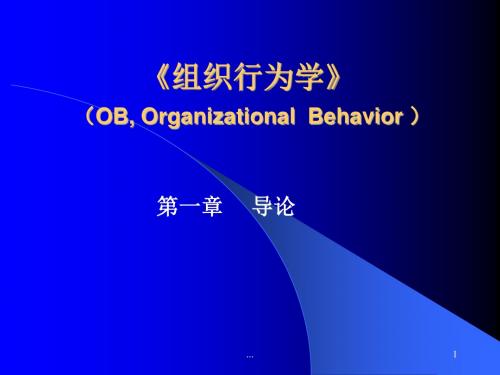
(二)人性的假设
对人的本质不同的认识,必然导致采取 不同的管理指导思想和采取不同的管理 模式。西方管理学、心理学中对人性提 出了各种理论,称为人性的假设。
...
19
1.“经济人”假设
(1) 什么是“经济人”假设: 经济人(rational-economic man )又称为实利人 或金钱人。出于享乐主义的哲学观点,起源于英 国经济学家亚当 . 斯密关于劳动交换的经济理论。 认为人的一切行为都是为了最大限度的满足自己 的私利。人都要争取最大的经济利益,工作是为 了获得经济报酬。人就是为了挣钱才干活。 泰勒称之为经济人,他认为资本家是为了获取最 大利益才开设工厂,而工人则为了获得经济报酬 来工作,只有劳资双方共同努力,大家都可得到好 处。泰勒曾把这种管理称为一次心理上的革命。
...
10
3.根据上述指标,可以了解:
是否贯彻以人为中心的管理思想和管理措施; 指标的高低,不决定于物质与工作条件,而是物质与 精神激励有无成效; 成功的单位各项指标中精神与物质是交叉排列的; 可以作为成功与否的诊断指标、单位努力的方向。
...
11
第一节
学科背景
一、管理概念的拓展
... 9
企业成败与职工的心理评价
1.人的因素是最稳定的因素; 2.心理评价指标: 方向感:职工明确地意识到本单位的发展方向,寄希望于它的发 展; 信任感:职工与领导相互信任,职工以主人翁的姿态; 成就感:领导 认识到单位的成就都与职工个人的成就有关; 职工 意识到自己工作的价值; 温暖感:职工的归属感,为职工排忧解难,人际关系和谐; 舒适感:对工作环境、条件感到比较舒适,有安全感; 实惠感:解决职工的切身利益,物质利益、热爱专业、安于职守;
组织行为学—OB个体行为2

己行为方面表现出相当高的(适应)性,
对环境线索十分敏感,能根据不同(情
境)采取不同行为,并能够使公开的角色
与私人的自我之间表现出极大差异。
.倾向于更关注他人的活动,行为更符合习
俗。在管理岗位上更易成功,因为它要求
个体扮演多重甚至相互冲突的(角色)。
.情绪智力包括:
–情绪(知觉,评价和表达能力)
–自我调控
–自我激励
–换位思考
–情绪(调控能力)
情绪智力
.以自我意识为基础,包括乐观、同
情心、情绪(自制)等,影响和支
配着人的决策和行为,对人的成
就具有(决定)性意义。
能力与组织管理
.合理招聘人才,量才录用
.能力与(职务)相匹配
.团队和领导班子中人的能力要(培
训)
.加强员工能力培训
.建立有效(业绩)评估制度
意志与行为
.意志的内涵:自觉地确定(目的),
并支配调节自己的行为,以克服各
种(困难),实现目的的心理过程。
发动、(坚持)、克制
意志与行为
.意志对行为的影响
–意志品质:自觉性、果断性、(坚持)性、自
所有的下级评价都(低);有的管理者宽
大无边,对所有的下级都评价偏(高);
也有的管理者对所有的下级评价都在平均
水平。这种倾向会导致评价机制的
(歪曲),导致激励失败。
启示:须对考评人员进行统一培训,增强沟通,并
运用(交叉)评估。
定型效应:是指人们在头脑中把形成的对某类知觉对象的形象固定下来,并对以后有关该类对象的(知觉)产生强烈影响的效应。
OB组织行为学知识整合

间断强化:分为比例强化和时距强化。Fixed-intervalschedule固定时距:每隔一段固定
的时间就给予一次强化。Variableintervalschedule可变时距:根据时间分配奖励,但
强化物是不可预测的。Fixed-ratioschedule固定比率:当个体的反应积累到一个固定数
二、简答(激励、group、 两个team)
激励:
1.激励的概念
●激励(Motivation)是指激发人的行为动机,使人有一股内在的动力,朝向所期望的
目标前进的活动过程,也就是常说的调动积极性的过程。
●激励又称为动机的激发。
●激励的对象是人本身及其行为。
●激励的实质是管理者通过采取各种能满足员工的合理、正当需要的诱因,激发其工作
不是成为群体成员进行活动的程度。Col
llectivism集体主义:一种民族文化属性,描
述的是人们生活在具有严谨架构的社会中,期望得到同一群体的其他人的照顾和保护。
.男性气质和女性气质
Masculinity男性气质:一种民族文化属性,它描述文化支持男性角色如成就、权力及
控制力的程度。Femininity女性气质:一种民族文化属性,,男女之间差异很小,强调
和持久。Short-termorientation短期取向:一种民族文化属性,强调过去和现在。
Personality-jobfittheory人格-工作适应性理论:由霍兰德提出。该理论提出了六种人
格类型:现实型、研究型、社会型、传统型、企业型、艺术型。并指出,员工对于工作的满
意度和流动意向取决于个体的人格特点与职业环境的匹配程度。
目后,便给予奖励。Variableratioschedule可变比率: 奖励根据个体行为的差异而发
组织行为学OB概述和个体行为
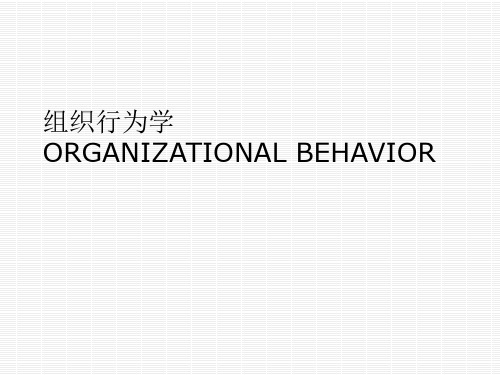
助教介绍
杨林锋 复旦大学管理学院博士生 Email:081025029@fudan edu cn 电话:15921427054
2 个体的生理特点
外貌 体重 慢性疾病 体质 在管理中要考虑哪些个体生理特点
Байду номын сангаас
3 个体的心理特点
人与动物最大的区别; 在于人的心理特点
(1) 遗传
智力 气质 生理 等等
2 环境
情商 性格 能力 等等
3 学习
经典条件反射 操作条件反射 社会学习理论
什么是学习
您的自尊高吗 测试一下
您的自尊高吗 答案
1 您是否有明确的人生目标 是 2 您是否被迫地做某些事 否 3 您喜欢自己吗 是 4 您经常感激他人吗 是 5 您是否因为对方的头衔而尊重对方 否 6 您的自信心强吗 是 7 您敢于冒适当的风险吗 是 8 您的行动力强吗 是 9 您是否经常讽刺弱者 否 10 您经常很快乐吗 是 11 您经常迁就他人吗 否 12 您敢于坚持自己的观点吗 是 13 您敢于承认自己的错误吗 是 14 您为自己的外表感到自豪吗 是 15 您是否经常担心为了会失去某些事物而感到恐惧 否
A 控制点
外控制点 内控制点
B 自尊
您认为自己的自尊高吗 为什么这么认为
什么是自尊
自尊是尊重自己;不向别人卑躬屈节;也不许别人歧 视 侮辱;自尊心 摘自《现代汉语》
自尊是认为自己在经历中有能力对付生活的基本 挑战;并有资格享受幸福的一种气质 摘自:纳撒尼尔 布伦博士Dr Nathaniel Branden 的定义:自尊概念的鼻祖
ob组织行为学名词解释
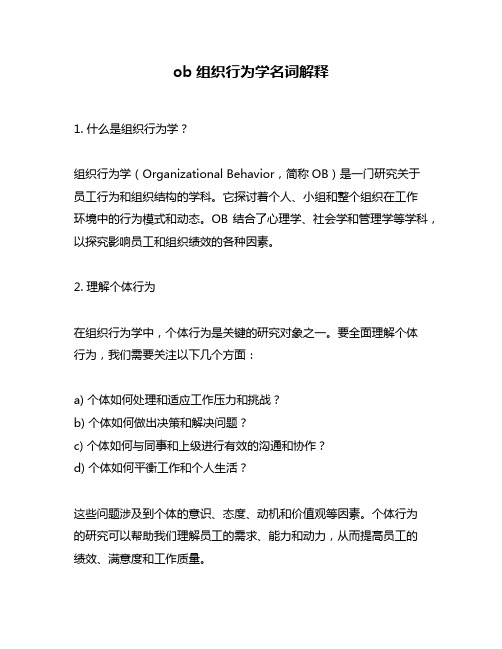
ob组织行为学名词解释1. 什么是组织行为学?组织行为学(Organizational Behavior,简称OB)是一门研究关于员工行为和组织结构的学科。
它探讨着个人、小组和整个组织在工作环境中的行为模式和动态。
OB结合了心理学、社会学和管理学等学科,以探究影响员工和组织绩效的各种因素。
2. 理解个体行为在组织行为学中,个体行为是关键的研究对象之一。
要全面理解个体行为,我们需要关注以下几个方面:a) 个体如何处理和适应工作压力和挑战?b) 个体如何做出决策和解决问题?c) 个体如何与同事和上级进行有效的沟通和协作?d) 个体如何平衡工作和个人生活?这些问题涉及到个体的意识、态度、动机和价值观等因素。
个体行为的研究可以帮助我们理解员工的需求、能力和动力,从而提高员工的绩效、满意度和工作质量。
3. 小组行为的重要性除了个体行为,小组行为也是组织行为学的关注点之一。
小组是组织中最基本的单位,它由互相协作的个体组成。
小组的研究可以帮助我们理解以下几个方面:a) 小组如何建立和维护良好的协作关系?b) 小组如何进行决策和解决冲突?c) 小组如何分配和协调工作任务?通过研究小组行为,我们可以提高团队的凝聚力、效率和创新力。
了解小组行为还有助于我们设计和实施有效的团队培训和组织发展计划。
4. 组织的结构和文化除了个体行为和小组行为,组织的结构和文化也是组织行为学的重要组成部分。
组织的结构涉及到职权和责任的分配、信息流动的路径以及决策的层级等方面。
组织的文化指的是共同的价值观、信念和行为规范。
研究组织结构和文化可以帮助我们理解以下几个方面:a) 组织如何通过结构来促进协作和沟通?b) 组织如何塑造和传递其核心价值观和行为规范?c) 组织如何应对和适应外部环境的变化?通过研究组织的结构和文化,我们可以优化组织的效率和灵活性,增强员工的认同感和忠诚度。
总结回顾:组织行为学是一门综合性学科,它研究的是员工行为和组织结构。
OB(2012秋导论)

◎ 答对8个或以上——知识比较广博; ◎ 若答对4个或更少——需要大大加强。
1)a;2)b;3)c; 4)b;5)d; 6)a;7)d;8)d;9)b;10)b.
前言
12/29/201 3
组织行为学 ORGANIZATION BEHAVIOR
□第7页□
◆ OB学科特点及要求
一、本课程的特点
1、OB理论性较强,根本任务是研究一定组织中人的行为规律。 2、OB研究的内容与社会实践密切相关。 3、OB学术流派思想很多, 绝非一家之言。 4、OB本身是从西方传入, 有如何结合我国的国情的问题。
第一章 组织行为学的研究对象
12/29/201 3
组织行为学 ORGANIZATION BEHAVIOR
□第11页□
二、管理者的角色——做什么事情?
60年代后期,麻省理工学院亨利〃明茨伯格 (Henry Mintzberg) 对5位高层经理研究得出结论: 管理者扮演着三大类(人际、信息和决策的角色)10种不同而又互相关联的角色。
a、讲授为主;b、鼓励讨论;c、倡导团队合作
2、教学目标
a、对政策法规要闻要有敏感性,即:关注—评论—联想—储备; b、对各行业变化要有自我分析判断能力; c、要有思考、写作与归纳能力; d、要有团队合作精神; 传播学本质方法(鱼与渔)——复杂--抽象--无情--俗--枯燥--弱--无生命。
3、考核方式及考题类型
家庭亲友产权所有者竞争者顾客供应商各级政府机关群众团体组织行为学组织行为学organizationbehaviororganizationbehavior第16页1231201第二章第二章组织行为学的历史沿革组织行为学的历史沿革一对obob有贡献的学科有贡献的学科二obob发展过程发展过程三管理学的突破三管理学的突破四早期主要代表人四早期主要代表人五古典主要代表人五古典主要代表人六现代主要代表人六现代主要代表人七当代主要代表人七当代主要代表人组织行为学组织行为学organizationbehaviororganizationbehavior第17页1231201第二章第二章组织行为学的历史沿革组织行为学的历史沿革一对obob有贡献的学科有贡献的学科个体群体组织系统ob的研究心理学社会学社会心理学人类学政治学组织行为学组织行为学organizationbehaviororganizationbehavior第18页1231201第二章第二章组织行为学的历史沿革组织行为学的历史沿革关心研究和理解个体的行为
- 1、下载文档前请自行甄别文档内容的完整性,平台不提供额外的编辑、内容补充、找答案等附加服务。
- 2、"仅部分预览"的文档,不可在线预览部分如存在完整性等问题,可反馈申请退款(可完整预览的文档不适用该条件!)。
- 3、如文档侵犯您的权益,请联系客服反馈,我们会尽快为您处理(人工客服工作时间:9:00-18:30)。
组织行为学:OB模型Developing an OB ModelA model is an abstraction of reality; a simplified representation of some real-world phenomenon.DEPENDENT VARIABLESDependent variables are the key factors you want to explain or predict. What are the primary dependent variables in OB? Scholars tend to emphasize productivity, absenteeism, turnover, and job satisfaction.1.ProductivityAn organization is productive if it achieves its goals, and does so by transferring inputs into outputs at the lowest cost. As such, productivity implies a concern for both effectiveness and efficiency.A business firm is effective when it attains its sales or market share goals, but itsproductivity also depends on achieving these goals efficiently. Measures of such efficiency may include return on investment, profit per dollar of sales, and output per hour of labor.In summary, one of OB's major concerns is productivity. We want to know what factors will influence the effectiveness and efficiency of individuals, of groups, and of the overall organization.2.AbsenteeismKeeping absenteeism low is very important to an organization. Levels of absenteeism beyond the normal range in any organization have a direct impact on that organization’s effectiveness and efficiency.Not all absences are bad. While most absences impact negatively on the organization, we can conceive of situations where the organization may benefit by an employee voluntarily choosing not come to work.For instance, fatigue or excess stress can significantly decrease an employee’s productivity. In jobs where an employee needs to be alert—surgeons and airline pilots are obvious examples—it may well be better for the organization if the employee does not report to work rather than show up and perform poorly. The cost of an accident in such jobs could be prohibitive.3.TurnoverVoluntary and involuntary permanent withdrawal from the organizationA high rate of turnover in an organization means increased recruiting, selection, andtraining costs. It can also mean a disruption in the efficient running of an organization when knowledgeable and experienced personnel leave and replacements must be found and prepared to assume positions of responsibility.Turnover often means the loss of people the organization does not want to lose. When turnover is excessive, or when it involves valuable performers, it can be disruptive factor, hindering the organization’s effectiveness.4.Job satisfactionJob satisfaction refers to a general attitude toward one’s job. The difference between the amount of rewards workers receive and the amount they believe they should receive.Job satisfaction represents an attitude rather than a behavior. The belief that satisfied employees are more productive than employees dissatisfied has been a basic tenet among managers for years.INDEPENDENT VARIABLESWhat are the major determinants of productivity, absenteeism, turnover, and job satisfaction? Our answer to that question brings us to the independent variables. Consistent with our belief that organizational behavior can best be understood when viewed essentially as a set of increasingly complex building blocks, the base or first level of our model lies in understanding individual behavior.1.Individual-level variablesPersonal or biographical characteristics such as age, gender, and marital status;personality characteristics; value and attitudes; basic ability level; Perception, individual decision making, learning, motivationThese characteristics are essentially intact when an individual enters the work force, and, for the most part, management can do little to alter them.2.Group-level variablesThe behavior of people in groups is more than the sum total of each individuals acting in their own way.The complexity of our model is increased when we acknowledge that people’s behavior when they are in groups is different from their behavior when they are alone. Therefore, the next step in the development of an understanding of OB is the study of group behavior.anizational system-level variablesJust as groups are more than the sum of their individual members, so are organizations more than the sum of their member groups.The design of the formal organization, technology and work processes, and jobs; the organization’s human resource policies and practices (that is, selection processes, training programs, and performance appraisal methods), the internal culture, and levels of work stress all have an impact on the dependent variables.。
